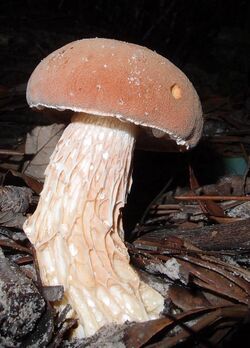Biology:Austroboletus occidentalis
| Austroboletus occidentalis | |
|---|---|

| |
| Scientific classification | |
| Domain: | Eukaryota |
| Kingdom: | Fungi |
| Division: | Basidiomycota |
| Class: | Agaricomycetes |
| Order: | Boletales |
| Family: | Boletaceae |
| Genus: | Austroboletus |
| Species: | A. occidentalis
|
| Binomial name | |
| Austroboletus occidentalis Watling & N.M.Greg. (1986)
| |
Austroboletus occidentalis, commonly known as the ridge-stemmed bolete, is a species of bolete fungus found in Australia. It was described as new to science in 1986 by mycologists Roy Watling and Norma M. Gregory.[1] The species name occidentalis is derived from the Latin occidens "west".[2].
The fruit body has a 5.5–10 cm diameter cap that has a texture reminiscent of suede or chamois and can be sticky/slimy when young. Initially orange- or pinkish-brown, it is subconical with a thickened margin, and flattens with age and fades an ochre colour. Like other boletes, it has tubes under the cap instead of gills. These are white in young specimens maturing to pink. The cylindrical white stipe is 7–16 cm tall and 1.7–2.5 cm wide, marked with deep lacunae.[3] The white flesh bruises yellowish and has a bitter taste. The edibility is unknown. The spore print is brown, the spores are cylindrical, 15–19 x 5–6.5 μm and covered entirely with warty lumps.[3]
Austroboletus occidentalis is a component of jarrah (Eucalyptus marginata) forests in southwestern Western Australia.[4] It has been found in coastal scrub in southeastern Tasmania.[5]
Austroboletus occidentalis establishes a new type of plant-fungus symbiosis (feremycorrhiza) with both woody plants (e.g. jarrah: Eucalyptus marginata) and herbaceous plants (such as wheat, barley), and even non-mycorrhizal plants such as canola. ‘Fere’ means ‘nearly’ in Latin; hence, the term ‘feremycorrhiza’ means ‘nearly mycorrhiza’.[6] This term is well suited for this symbiosis because of i) The Australian native fungus A. occidentalis phylogenetically belongs to an ectomycorrhizal (ECM) lineage, ii) A. occidentalis possesses several established hallmarks of the ECM symbiosis, and iii) A. occidentalis does not enter roots and hence does not form any interface structures in the root. Therefore, it is not a fully developed mycorrhiza structurally; it is a ‘nearly’ mycorrhiza (with mycorrhiza-like effects on plant growth and nutrition). Austroboletus occidentalis has ECM lineage (Boletaceae) and several typical features of ECM fungi (e.g. strong phosphorus solubilization activity, limited saprotrophic capacity, lack of invertases, utilization of hexoses but not sucrose, polyphosphate biosynthesis).[7][8][9] Furthermore, lack of root colonization in the feremycorrhizal symbiosis has presumably led to a broader range of host plants (woody/herbaceous plants; mycorrhizal/non-mycorrhizal plants), as compared to ECM fungi (e.g. ECM-forming Austroboletus species) that are, generally, limited to woody plants.
References
- ↑ "Observations on the boletes of the Cooloola sandmass, Queensland and notes on their distribution in Australia: Part 3. Lamellate taxa". Proceedings of the Royal Society of Queensland 97 (3): 97–128. 1986. doi:10.1017/S0960428600003085.
- ↑ Simpson DP. (1979). Cassell's Latin Dictionary (5 ed.). London: Cassell Ltd. p. 407. ISBN 0-304-52257-0.
- ↑ 3.0 3.1 Fungi of Southern Australia. Nedlands, Western Australia: University of Western Australia Press. 1998. p. 300. ISBN 978-1-875560-80-6.
- ↑ The Jarrah Forest: A complex mediterranean ecosystem. New York, New York: Springer Science & Business Media. 2012. pp. 91. ISBN 9789400931114. https://books.google.com/books?id=8xUkCQAAQBAJ&q=Austroboletus+occidentalis&pg=PA96.
- ↑ "An inventory of macrofungi observed in Tasmanian forests over a six-year period". Tasforests 16: 153–68. 2005. Archived from the original on 2013-12-29. https://web.archive.org/web/20131229003422/http://www.forestrytas.com.au/assets/0000/0254/tasforests_16_11_web.pdf.
- ↑ Kariman, Khalil; Barker, Susan Jane; Tibbett, Mark (2018-12-04). "Structural plasticity in root-fungal symbioses: diverse interactions lead to improved plant fitness" (in en). PeerJ 6: e6030. doi:10.7717/peerj.6030. ISSN 2167-8359. PMID 30533314.
- ↑ Kariman, Khalil; Moreira-Grez, Benjamin; Scanlan, Craig; Rahimlou, Saleh; Boitt, Gustavo; Rengel, Zed (2022-02-01). "Synergism between feremycorrhizal symbiosis and free-living diazotrophs leads to improved growth and nutrition of wheat under nitrogen deficiency conditions" (in en). Biology and Fertility of Soils 58 (2): 121–133. doi:10.1007/s00374-021-01616-7. ISSN 1432-0789.
- ↑ Kariman, Khalil; Rengel, Zed; Pena, Rodica; Rahimlou, Saleh; Tibbett, Mark (2023-02-01). "Response to "Feremycorrhizal fungi: A confusing and erroneous term": Feremycorrhiza means 'nearly mycorrhiza'; hence, it is a clear and correct term because the fungal partner has mycorrhizal traits and lineage" (in en). Soil Biology and Biochemistry 177: 108934. doi:10.1016/j.soilbio.2022.108934. ISSN 0038-0717. https://www.sciencedirect.com/science/article/pii/S0038071722003911.
- ↑ Kariman, Khalil; Scanlan, Craig; Boitt, Gustavo; Rengel, Zed (2020-12-01). "Feremycorrhizal symbiosis confers growth and nutritional benefits to mycorrhizal and non-mycorrhizal crops" (in en). Soil Biology and Biochemistry 151: 108060. doi:10.1016/j.soilbio.2020.108060. ISSN 0038-0717. https://www.sciencedirect.com/science/article/pii/S0038071720303564.
External links
Wikidata ☰ Q20685970 entry
 |

